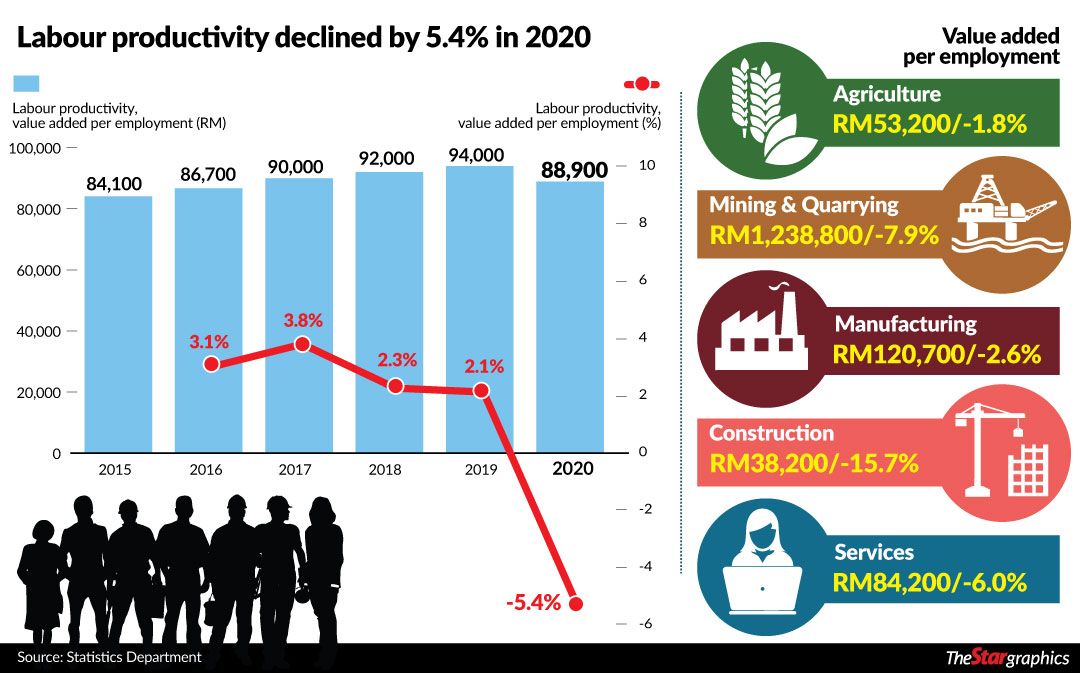Malaysia: Labour productivity growth to improve
PETALING JAYA: Malaysia’s labour market has been suffering from weak productivity growth in the past several years.
The country, which aspires to be a high-income nation, has also seen its productivity levels lagging behind Singapore, Japan and South Korea – key regional economies that had once trailed Malaysia in terms of economic size per capita.
In 2020, Malaysia’s labour productivity performance worsened further against the backdrop of a virus outbreak that ravaged the global economy. Based on the latest data from the Statistics Department, Malaysia’s labour productivity declined by 5.4% in 2020, following two consecutive years of slowing growth.
All economic sectors registered a contraction in labour productivity per employment last year. The biggest decline was seen in the construction industry where labour productivity plummeted by 15.7%.
On the contrary, the smallest contraction was in the agriculture sector at 1.8%. Looking ahead into 2021, economists agree that the domestic labour productivity will likely recover as businesses no longer have to endure mandatory operational shutdowns in response to Covid-19.
However, productivity levels may remain soft as long as the country is yet to see major improvement in economic activities.
Alliance Bank chief economist Manokaran Mottain (pic below) told StarBiz that it may take at least a year for labour productivity to return to pre-coronavirus levels.
“Nevertheless, the productivity growth may turn positive this year, albeit a moderate increase. With the economy recovering, we should see an increase in output and also improved productivity, ” according to him.
Meanwhile, Bank Islam Malaysia Bhd chief economist Mohd Afzanizam Abdul Rashid (pic below) said labour productivity growth could be higher in 2021, in view of the low base last year.
In 2020, labour productivity as measured by value added per employment dropped by RM88,899 per person as compared to RM93,973 per person in 2019.
“The manufacturing sector appears to be the main beneficiary of global growth this year, and therefore, labour productivity in this sector could move in tandem as a result, leading other economic sectors, ” he said.
When asked whether the weak labour productivity conditions will affect wage growth in 2021, Mohd Afzanizam said “it certainly will”.
“Currently, it is deemed to be the employers’ market. However, the wages would differ based on the workers’ skillset. Perhaps, highly skilled workers may not experience a severe decline in wage growth as the business operating landscape remains extremely competitive and in order to stay ahead of the curve, companies need to hire experienced and skilled employees, ” he said.
In a statement yesterday, chief statistician Datuk Seri Mohd Uzir Mahidin (pic below) said that the Covid-19 pandemic had forced businesses to re-examine their existing business operation models and explore new opportunities through digitalisation.
“The adoption of technology will improve efficiency in production and subsequently escalate productivity in the medium and long terms. An increase in production and productivity will drive profitability, and hence sustain businesses as well as retaining employment and creating job opportunities, ” he added.
For full year 2020, despite a contraction in labour productivity as measured by value added per employment, Mohd Uzir said labour productivity by value added per hour worked went up by 3.4% as compared to 2.2% in 2019. This translates to a value of RM42 per hour in 2020 in comparison to RM41 a year earlier.
Total hours worked for the year 2020 amounted to 32 billion hours, marking a reduction of 8.7% from 2019’s 35 billion hours.
“During the year, economic performance indicated by value added declined sharply by 5.6% as compared to 4.3% in 2019, while employment decreased 0.2% from 2.1% in 2019, ” according to Mohd Uzir.
The department reported that labour productivity continued to decline by 2.9% in the fourth quarter of 2020 after registering a contraction of 2.2% in the third quarter. By sector, manufacturing was the only sector that posted a positive growth of 3.2% in the quarter, in terms of value added per employment.
Source: https://www.thestar.com.my/business/business-news/2021/02/18/labour-productivity-growth-to-improve


 Thailand
Thailand







